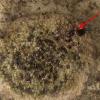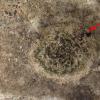
12-11-2025 09:25
 Viktorie Halasu
Viktorie Halasu
Hello, I need help with a pale terrestric Pseudom

11-11-2025 20:16
Bohan JiaHi, lastly I have found these tiny yellow decayin

09-11-2025 13:20
Hello.A tiny ascomycete, appearing as erupting gra

08-11-2025 00:29
 Francois Guay
Francois Guay
I found this species in Quebec, Canada, on herbace
Réaction à la paraphénylènediamine
Gonzalez Garcia Marta,
20-03-2022 10:23
J'étudie un Rhizocarpon et j'ai besoin de connaître sa réaction à la paraphénylènediamine pour l'identifier. C'est la première fois que j'utilise ce réactif et je ne sais pas si je dois considérer ma réaction comme positive ou négative. Je m'attendais à un contrecoup comme Xanthoria avec KOH, mais ce n'est pas le cas. De plus, les cristaux de paraphénylènediamine sont devenus roses mais le thalle est inchangé.
Au départ, j'avais mis les cristaux dans un verre et dilué l'éthanol dessus, mais étant tellement volatils, j'ai mis les cristaux directement sur le thalle du lichen en laissant tomber l'éthanol. Est-il possible que ma technique ne soit pas adéquate?
J'aimerais connaître l'avis de quelqu'un qui a étudié ce type de lichens.
Merci.
Franz Berger,
20-03-2022 22:03

Re : Réaction à la paraphénylènediamine
Best to consult lichenological books for the proper application of P for determination!
P in alcohol 96% is nor stabiel for more than 3 days, Your image seems to be the result of application of too old reagent?
So, it is recommended to keep all specimens back where this this reaction is necessary and make a new solution for these. Dark coloured sufaces dont show a distinct reaction, a cut to uncover the mark layer is favorablie some times. CAVE, alcoholic solutions are running very quick into the specimen, so try only at a part at the margin and omit the tinged part afterward.
Reactions:
no reaction = P-
possible reactions are P+ red (e.g. Fumarprotocetraacid; P+orange P+ yellow (prsoromic acid); it should be noticed, if the reaction is running slowly or quickly.
CAVE: This reagent causes irreversible aweful stains on surfaces like wood or also stones!
Hoping to help You with this
Franz
P in alcohol 96% is nor stabiel for more than 3 days, Your image seems to be the result of application of too old reagent?
So, it is recommended to keep all specimens back where this this reaction is necessary and make a new solution for these. Dark coloured sufaces dont show a distinct reaction, a cut to uncover the mark layer is favorablie some times. CAVE, alcoholic solutions are running very quick into the specimen, so try only at a part at the margin and omit the tinged part afterward.
Reactions:
no reaction = P-
possible reactions are P+ red (e.g. Fumarprotocetraacid; P+orange P+ yellow (prsoromic acid); it should be noticed, if the reaction is running slowly or quickly.
CAVE: This reagent causes irreversible aweful stains on surfaces like wood or also stones!
Hoping to help You with this
Franz
Gonzalez Garcia Marta,
21-03-2022 13:19
Re : Réaction à la paraphénylènediamine
Muchas gracias Franz.


